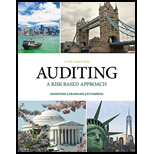
Auditing: A Risk Based-Approach (MindTap Course List)
11th Edition
ISBN: 9781337619455
Author: Karla M Johnstone, Audrey A. Gramling, Larry E. Rittenberg
Publisher: Cengage Learning
expand_more
expand_more
format_list_bulleted
Concept explainers
Question
Chapter 6, Problem 10RQSC
To determine
Introduction:
To evaluate: The procedures followed by the auditors in the circumastances hereby provided.
Expert Solution & Answer
Trending nowThis is a popular solution!

Students have asked these similar questions
Financial Accounting Question please answer
David Corp. manufactures 2 products, drills and wrenches. The company has estimated its overhead in the assembly department to be $200,000. The company produces 500,000 drills and 400,000 wrenches each year. Each drill uses 4 parts, and each wrench uses 5 parts. How much of the assembly overhead should be allocated to drills? Answer
Provide correct solution and general accounting question
Chapter 6 Solutions
Auditing: A Risk Based-Approach (MindTap Course List)
Ch. 6 - Prob. 1CYBKCh. 6 - Prob. 2CYBKCh. 6 - Prob. 3CYBKCh. 6 - Which of the following statements is true...Ch. 6 - Prob. 5CYBKCh. 6 - Prob. 6CYBKCh. 6 - Prob. 7CYBKCh. 6 - Prob. 8CYBKCh. 6 - Prob. 9CYBKCh. 6 - Prob. 10CYBK
Ch. 6 - Prob. 11CYBKCh. 6 - Prob. 12CYBKCh. 6 - Prob. 13CYBKCh. 6 - Prob. 14CYBKCh. 6 - Prob. 15CYBKCh. 6 - Prob. 16CYBKCh. 6 - Prob. 17CYBKCh. 6 - Prob. 18CYBKCh. 6 - Prob. 19CYBKCh. 6 - Prob. 20CYBKCh. 6 - Prob. 1RQSCCh. 6 - Prob. 2RQSCCh. 6 - Prob. 3RQSCCh. 6 - Prob. 4RQSCCh. 6 - Refer to Exhibit 6.2 and describe the differences...Ch. 6 - Prob. 6RQSCCh. 6 - Prob. 7RQSCCh. 6 - Prob. 8RQSCCh. 6 - Prob. 10RQSCCh. 6 - Prob. 11RQSCCh. 6 - Prob. 12RQSCCh. 6 - Prob. 13RQSCCh. 6 - Prob. 14RQSCCh. 6 - Prob. 15RQSCCh. 6 - Indicate how the auditor could use substantive...Ch. 6 - Prob. 17RQSCCh. 6 - Prob. 18RQSCCh. 6 - Prob. 19RQSCCh. 6 - Prob. 20RQSCCh. 6 - Prob. 21RQSCCh. 6 - Prob. 22RQSCCh. 6 - Prob. 23RQSCCh. 6 - Prob. 24RQSCCh. 6 - Prob. 25RQSCCh. 6 - Prob. 26RQSCCh. 6 - Prob. 27RQSCCh. 6 - Prob. 28RQSCCh. 6 - Prob. 29FFCh. 6 - Prob. 30FFCh. 6 - Prob. 31FFCh. 6 - Prob. 32FFCh. 6 - Prob. 33FFCh. 6 - MINISCRIBE (LO 1, 2) As reported in the Wall...
Knowledge Booster
Learn more about
Need a deep-dive on the concept behind this application? Look no further. Learn more about this topic, accounting and related others by exploring similar questions and additional content below.Similar questions
- Provide correct solution and accounting questionarrow_forwardDescribe any one threat/risk in either the revenue cycle (i.e., in sales and cash collection activities) or the expenditure cycle (i.e., in purchases or cash disbursement activities)arrow_forwardNeed help with this accounting question not use aiarrow_forward
arrow_back_ios
SEE MORE QUESTIONS
arrow_forward_ios
Recommended textbooks for you
 Auditing: A Risk Based-Approach (MindTap Course L...AccountingISBN:9781337619455Author:Karla M Johnstone, Audrey A. Gramling, Larry E. RittenbergPublisher:Cengage Learning
Auditing: A Risk Based-Approach (MindTap Course L...AccountingISBN:9781337619455Author:Karla M Johnstone, Audrey A. Gramling, Larry E. RittenbergPublisher:Cengage Learning Auditing: A Risk Based-Approach to Conducting a Q...AccountingISBN:9781305080577Author:Karla M Johnstone, Audrey A. Gramling, Larry E. RittenbergPublisher:South-Western College Pub
Auditing: A Risk Based-Approach to Conducting a Q...AccountingISBN:9781305080577Author:Karla M Johnstone, Audrey A. Gramling, Larry E. RittenbergPublisher:South-Western College Pub

Auditing: A Risk Based-Approach (MindTap Course L...
Accounting
ISBN:9781337619455
Author:Karla M Johnstone, Audrey A. Gramling, Larry E. Rittenberg
Publisher:Cengage Learning

Auditing: A Risk Based-Approach to Conducting a Q...
Accounting
ISBN:9781305080577
Author:Karla M Johnstone, Audrey A. Gramling, Larry E. Rittenberg
Publisher:South-Western College Pub